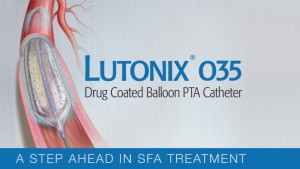
Vascular and Vein Surgery
What is the Lutonix® 035 Drug Coated Balloon?
Lutonix® 035 Drug Coated Balloon is a balloon catheter with the drug paclitaxel applied to the balloon. With exception of the drug coating, the Lutonix®035 Drug Coated Balloon is similar to other conventional balloon catheters. The clinical data demonstrates that the Lutonix®035 Drug Coated Balloon is as safe and is superior in preventing renarrowing of the artery as compared to conventional balloon catheters for treatment of patients who suffer from PAD.
Watch Lutonix 035 Video
What is paclitaxel?
Paclitaxel is the active drug component of the utonix® 035 Drug Coated Balloon. Paclitaxel is used for cancer treatment and may help prevent renarrowing of the artery. The Lutonix®035 Drug Coated Balloon uses a small amount of paclitaxel (around 2% of a single cancer treatment) and the drug is applied directly to the vessel wall.Lutonix® 035 Drug Coated Balloon PTA Catheter.
Who should not receive a Lutonix®035 Drug Coated Balloon?
•Women who are breastfeeding, pregnant or are intending to become pregnant or men intending to father children.
•Patients with known hypersensitivity to paclitaxel or structurally related compounds.
•Patients who cannot receive recommended anti-platelet and/or anticoagulant therapy.
•Patients judged to have a lesion that prevents complete
inflation of an angioplasty balloon or proper placement of the delivery system.
What are the potential adverse events associated with the Lutonix® 035 Drug Coated Balloon?
Potential adverse events which may be associated with an angioplasty procedure such as when using the Lutonix®035 Drug Coated Balloon include:
• Additional intervention
• Allergic reaction to drugs or contrast medium
• Amputation/loss of limb
• Aneurysm or pseudoaneurysm
• Arrythmias
• Embolization
• Hematoma
• Hemorrhage, including bleeding at the puncture site
• Hypotension/hypertension
• Inflammation
• Occlusion
• Pain or tenderness
• Pneumothorax or hemothorax
• Sepsis/infection
• Shock
• Stroke
• Thrombosis
• Vessel dissection, perforation, rupture, or spasm
Potential adverse events, not described in the above source, which may be unique to the paclitaxel drug coating include:
•Allergic/immunologic reaction to the drug coating (paclitaxel)
•Alopecia
•Anemia
•Blood product transfusion
•Gastrointestinal symptoms
•Hematologic dyscrasia (including leukopenia, neutropenia, thrombocytopenia)
•Hepatic enzyme changes
•Histologic changes in vessel wall, including inflammation,
cellular damage, or necrosis
•Myalgia/Arthralgia
•Myelosuppression
•Peripheral neuropathy
Before the procedure
Your doctor will explain how to prepare for your angioplasty procedure before you are admitted to the hospital. You may be asked to avoid eating or drinking anything after midnight on the night before the procedure. You may also be asked to take aspirin or other medication for a few days prior to the procedure to thin your blood and prevent clots from forming.
During the procedure
Your angioplasty procedure will take place in the hospital or in a catheterization lab. Although you may be given a sedative to help you relax, you will be awake during the procedure. This will allow you to follow your doctor’s instructions to move, cough or breathe as needed.
Your doctor will be accessing your artery through your groin. The access area will first be shaved, swabbed with antiseptic and numbed with a local anesthetic. Your doctor will then make a small incision in your skin and gain access to your artery with a needle. A wire guide will be inserted through the needle and advanced to the part of your artery that contains the blockage. The doctor will then insert an introducer sheath over the wire guide into your artery, and the Lutonix® 035 Drug Coated Balloon will be advanced through the introducer sheath to the site of the blockage. The balloon will be inflated briefly, widening the blocked artery. The introducer sheath may also be left in place for a few hours while you are monitored.
After the procedure
When your procedure is finished, you will be moved to a recovery area. You may feel some discomfort, which can be relieved with pain medicine. Your blood pressure and heart rate will be monitored closely. Your doctor and the standard protocol of the facility where your procedure was performed will determine when you are allowed to go home.
Summary of Clinical Information
The Lutonix®035 Drug Coated Balloon was evaluated in the LEVANT II Clinical Study. The LEVANT II Clinical Study enrolled 476 patients. After one year, it was determined that the procedure was successful in most patients and that the Lutonix®035 Drug Coated Balloon was more successful at preventing renarrowing of the arteries than conventional balloon catheters. Although there is limited information for the female population, the treatment effect was reduced in women as compared to men. Additional data is needed to determine whether different outcomes are expected in women. The safety of using a Lutonix®Drug Coated Balloon was comparable to using a conventional balloon catheter. The results of this study showed that the Lutonix®035 Drug Coated Balloon is safe and effective for treating superficial femoral or popliteal artery stenoses. Your doctor can explain the risks and benefits that are specific to you.


